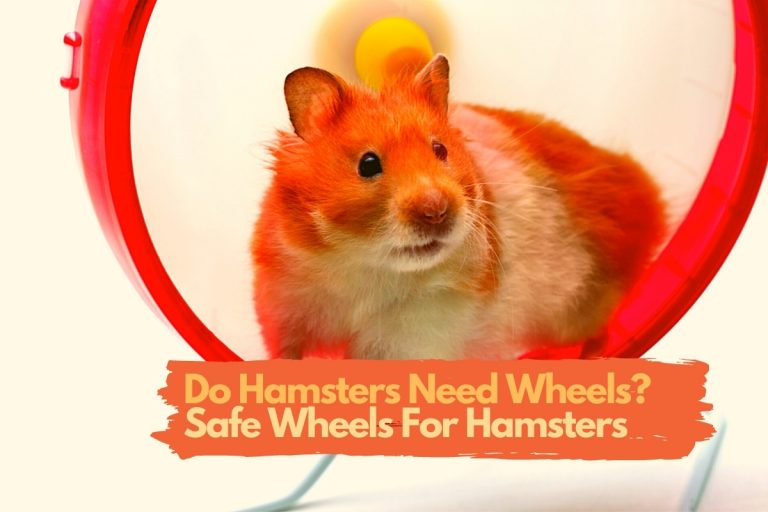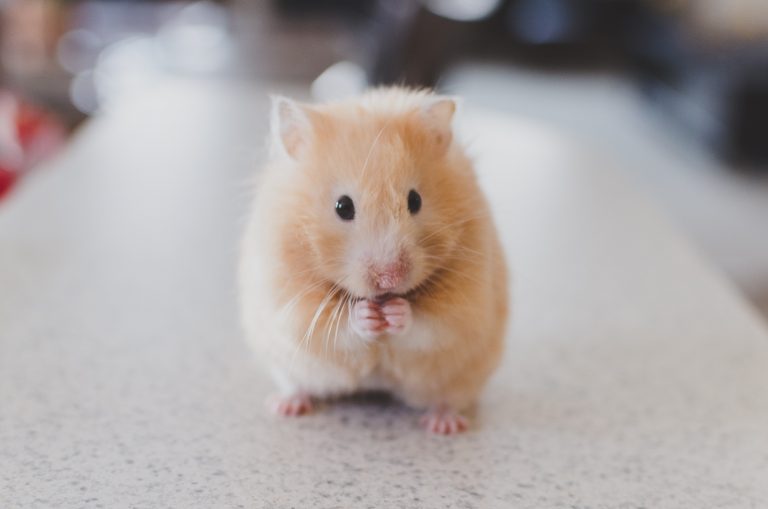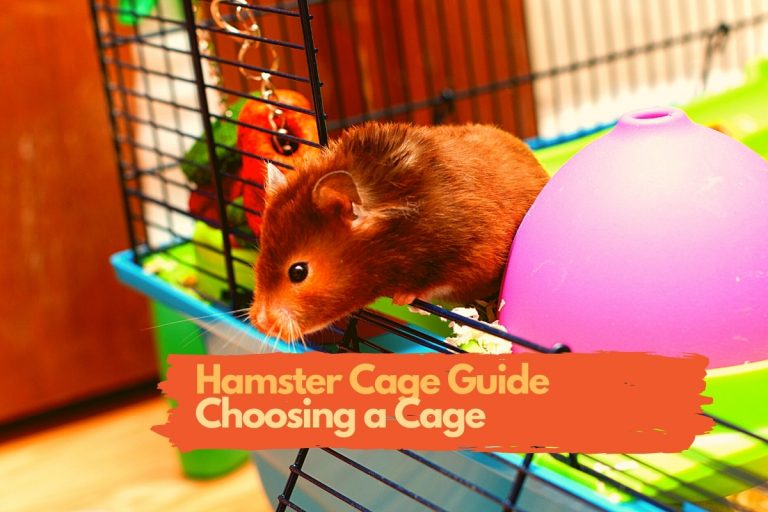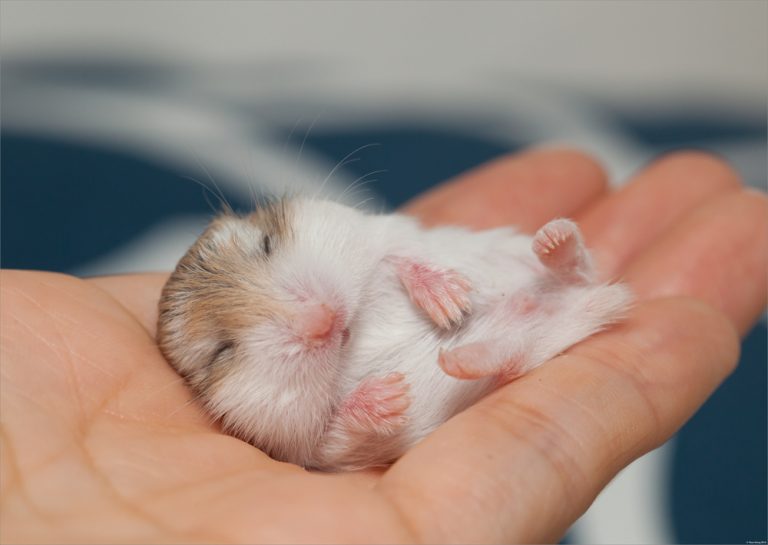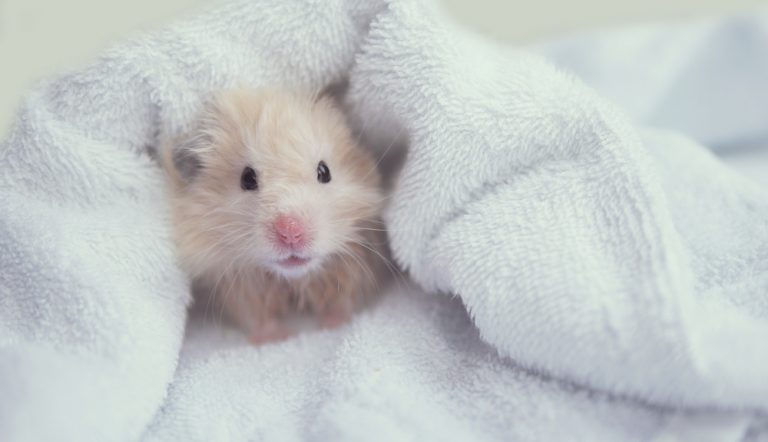Hamster Substrate & Bedding | Safe and Suitable Materials
When you’ve chosen your hamster cage, you’ll need to make the next important decision: the substrate and bedding you’ll use for your hamster or dwarf hamster. There are different kinds of substrates and bedding available and some are safe for hamsters while others aren’t.
The best substrate (also called bedding) for hamsters and dwarf hamsters is a plant-based substrate that is absorbent, controls odors, is non-toxic, and is suitable for burrowing. You can combine different substrates such as aspen wood shavings, a paper-based substrate, and hay.
Substrate comes in different forms. Some are safe to use with hamsters, while others are hazardous for them. It’s essential to know how to separate the good from the harmful types of substrate. The same goes for bedding material.
In this article, you’ll learn exactly how to pick the right kind of substrate and bedding for your hamster cage. At the end of the article, you’ll know what types are suitable for hamsters and which ones to absolutely avoid.
This site contains affiliate links to products we recommend and use ourselves. We may receive a commission for purchases that you make through these links. If you’re interested in learning more about our affiliate links, please visit our (affiliate) disclaimer.
What’s the Difference Between Substrate and Bedding?
Hamsters and dwarf hamsters are burrowing pets and can’t live in a cage without a substrate on the cage floor. But what is a substrate and what is bedding?
Substrate and bedding are sometimes used as synonyms but they’ve got a very different use. Most substrates can also be used as a bedding material, which has caused the line between the two to be a little bit blurry.
What’s the use of substrate?
- keep the cage clean and hygienic
- create a soft walking area for your hamsters
- is used to let your hamsters burrow and create tunnels
- sometimes is also used as nesting material
What’s the use of bedding?
- is used as nesting material
Hamster Cage Substrate
What’s important when choosing a substrate?
General guidelines
Any material you use in your hamster cage should be safe and suitable for your hamsters and dwarf hamsters.
Don’t pick the first substrate you see in a pet store or online. As you might already know, not everything that is marketed at hamsters is suitable for them.
The following factors have to be considered to determine the safety and suitability of substrate for (dwarf) hamsters:
- toxicity
- odor-control
- hypoallergenic
- absorbent
The most important factor is that the substrate shouldn’t be toxic or in any way harmful for hamsters. Hamsters can sometimes chew and ingest substrate. Some types of substrates aren’t very safe to ingest and should be avoided for this reason.
Two other important factors when picking a substrate is that it will need to control the odors and be absorbent. Hamsters will urinate and in a closed environment (even with ventilation) the smells will need to be reduced and the urine will need to be absorbed by the substrate.
Something that isn’t always important is the hypoallergenic property of the substrate. Some people suffer from allergies and most allergies aren’t caused by the pet but by the substrate. Some substrate types contain a lot of dust, which can become airborne and harm you and your hamsters.
Specific hamster needs
Hamsters and dwarf hamsters use burrows in the wild. In captivity, your hamsters will need to be able to do the same to reduce stress and increase the lifespan. Just like gerbils, hamsters are burrowing pets and need a deep layer of substrate.
If you only give a thin layer of substrate or the substrate isn’t suitable for burrowing, your hamsters won’t be happy. So always choose a substrate that is suitable for digging and making burrows.
Extra tips
You should, besides the factors mentioned above, also consider a few less important factors. These factors influence what kind of substrate you get:
- easy to clean
- weight of the material
- budget
Some substrate types can clog and become hard when they contact water (and urine). Such types are a bit harder to clean, although not impossible of course.
There are lightweight and heavyweight substrates. The lightweight material can be kicked out of the cage more easily and can mess up your home. You can avoid this by using a vivarium instead of a wire cage.
If you’re on a budget, you want to consider getting a budget-friendly (safe) substrate. There are some slight differences in price and a cheap substrate is usually of less quality.
What kinds of cage substrate are there?
When you look at the substrate online or in pet stores you’ll probably be unsure what type of substrate to get. Let’s take a look at the kinds of cage substrate there are available for rodents and hamsters.
Wood shavings
Wood shavings are a popular substrate for a lot of animals, including rodents. It’s also possibly the oldest form of substrate for animals. Shavings are a waste product from lumber production and usually have a curly look.
Wood shavings can come from different kinds of trees but most commercial wood shavings will come from pines, cedars or aspen trees.
Paper-based substrate
More recent, commercial substrate is based on (recycled) paper. These paper-based substrates come in all kinds of shapes, sizes and even colors. There are some concerns with recycled paper. They can still contain ink residues, although most paper-based substrate is safe enough to use.
Wood pulp substrate
Wood pulp substrate is related to a paper-based substrate and it’s not always as easy to make the difference between these two substrates. They have roughly the same properties and are more expensive substrate types. Wood pulp substrate is made of natural wood fibers.
Hay/Straw
Hay and straw are sometimes confused with each other. Hay is the product of cutting a plant before the plant starts producing seeds. The result is a high-quality fiber. Hay has a high nutritional value and is used as feeding material. Hamsters naturally don’t really eat a lot of hay but can use it to file their teeth down.
On the other hand, straw is the stalk of the plant after the seeds have been harvested. It’s a byproduct of harvest and has little nutritional value. The value of straw lies in its use as substrate and bedding material. It’s an excellent material because it doesn’t develop mold as quickly and has a low cost.
Pellets
Wood and paper pellets are made from trees or recycled paper. They look like tiny tubes or even food. Pellets are often used as a substrate for rodents and other small pets.
Corn cob
A less common substrate for hamsters is corn cob. It’s more known as a substrate for bird cages. Corn cob is made from the dried granulated cob from corn. It’s in fact the central core of an ear of corn. Corn cob substrate looks like small almost round particles.
Hemp
Hemp bedding is made from the inner core of the hemp stalk. This core is made from fibers that have a high absorbency and also are good at reducing odors. It’s a biodegradable and compostable type of bedding that’s safe to chew and may be ingested by your hamsters.
Sand
Most hamsters and dwarf hamsters live in an arid environment and sand as a substrate would create a more natural-looking environment for them in captivity. Sand is sometimes used as a substrate as long as it’s sterile but is also used as a bath for hamsters just like chinchillas use a sand or dust bath.
Cat litter
When you think of cat litter you probably won’t think to use it as a substrate for hamsters. But cat litter is a possible substrate you can find in stores and online. Cat litter is typically made of granulated clay or bentonite, a special kind of clay, and is known for its absorbent properties and odor-control.
Safe substrate types for hamster cages
Important notice: online stores and pet stores often use the term “cage bedding” or just “bedding” to indicate substrate. Below I’ll go through suitable substrates for hamsters. Later on, I’ll get into the real bedding material.
The following substrate types are safe (non-toxic) to use for (dwarf) hamsters:
- aspen wood shavings
- paper-based substrate
- corn cob substrate
- hemp substrate
But not all of these substrate types are suitable for tunneling and some are more expensive than others. Below you’ll find a short description of each safe substrate type and the pros and cons for each one.
Aspen wood shavings
Wood shavings are usually not that suitable as a substrate for your hamsters because they contain phenols which can be dangerous for small animals. Aspen shavings are generally considered to be safer than pine and cedar shavings. These shavings are made from hardwood and are almost dust-free and are non-aromatic.
Aspen shavings can be chewed and are non-toxic natural materials. Hamsters will chew on the shavings. The resulting wood pulp can be used to build tunnels. However, on its own, the shavings aren’t great for tunneling. You can help your hamsters by putting in toilet rolls as fixed tunnels or mixing it up with other kinds of substrate to make sturdy tunnels.
Paper-based substrate
Most paper-based substrates will have a higher absorbency than wood shavings (usually 2 times better) and they contain far less dust than shavings.
The downside is that they’re a bit more expensive than aspen wood shavings. However, most hamster owners will use paper-based substrate from recycled paper or even from new (never-used) paper.
Corn Cob substrate
Corn Cob bedding is usually marketed for birds but is also recommended as a substrate for small rodents, like hamsters. It’s known for its high absorbency and odor-control but is also the more expensive kind of substrate. It also isn’t suitable for making good tunnels or nests because corn cob can’t be shredded in tiny pieces like other materials.
Hemp substrate
Hemp substrate is a fairly unknown type of substrate for hamsters but is gaining popularity in certain regions. It’s possible that it’s very difficult to find in your region or even unavailable.
Hemp is a fairly expensive substrate but has all advantages of paper-based substrate and is a popular alternative for wood shavings because of it’s low amounts of dust.
Substrates to absolutely avoid
A lot of available substrates aren’t suitable for hamsters and should be avoided at all costs. Never use any of the following substrates for your hamsters:
- sawdust
- wooden or paper pellets
- pinewood and cedarwood shavings
- cat litter
- sand
Sawdust
Sawdust is a soft and lightweight substrate that’s definitely not suitable for hamsters and other small pocket pets. This substrate contains a lot of tiny dust particles that become airborne very fast. The tiny particles will end up in your hamsters’ lungs and will usually lead to respiratory problems.
Wooden or paper pellets
Wooden or paper pellets are relatively small but are highly absorbent. Hamsters will chew on their substrate and can ingest parts of it. If your hamsters ingest pellets they will swell inside their body and this can cause an obstruction of the intestinal tract. Pellets are also hard and can, just like a wire mesh floor, cause injuries to the feet of your little critters.
Pinewood and cedarwood shavings
Wood shavings from pine and cedar trees contain the following substances:
- naturally occurring phenols
- abietic (pines) or plicatic acid (cedars)
Phenols can be toxic and cause acid burns in high quantities. The phenols have a low molecular weight which makes them become airborne very easily. When they’re airborne they can be inhaled by your hamsters. This might lead to your hamster dying in a matter of hours depending on the concentration of phenols in the shavings.
Pine trees are a species of conifer trees and contain abietic acid while cedar trees contain a unique kind of acid called plicatic acid. Both acids are the cause of skin and respiratory irritations. Plicatic acid can also worsen asthma and cause allergic reactions.
Kiln drying is a process where excess water is removed from the wood. Kiln drying is used to among other things remove phenols from the wood. However, there will still be small concentrations of phenols in the shavings. The concentration of phenols depends on a lot of different factors. Kiln drying also doesn’t remove the above-mentioned acids from the wood.
Cat litter
Cat litter is sometimes indicated as a substrate for small pets but you should never use cat litter as a substrate for your hamster cage. It has high absorbent properties and can cause obstruction when ingested by your hamsters because the litter will swell up. The structure of cat litter is comparable to pellets and can cause injuries to the feet of your little hamster.
Nowadays, there are some unscented and non-clumping cat litters available that are paper-based. But these are not suitable for creating tunnels so it’s best to get some substrate that is designed for hamsters (and rodents in general).
Sand
Sand is generally a safe substrate for hamsters but I wouldn’t recommend it as the only substrate you use. It’s a lightweight kind of substrate that gets kick around very easily and can be difficult to clean. Sand isn’t a good substrate if you want to control the odors in the cage and can also dry out which causes tunnels to collapse.
For this reason, I would choose to give only a small bowl of sand to your hamsters so they can get in and clean their fur. I would never use it as a substrate because it needs to stay damp to create good tunnels and other substrates are way better to create stable tunnel networks for your hamsters.
Tips for choosing and using substrate
Now you know the safe and harmful kinds of substrates for hamsters. There are some tips I want to give you for using the substrate. Below you’ll find the 5 most important tips related to substrates:
- use a combination of substrate types: most substrates have absorbent properties but lack the sturdiness to let your hamsters create tunnels that don’t collapse. Use different kinds of substrates to benefit from the advantages of each kind of substrate. For example, use a combination of hay, aspen wood shavings, and a paper-based substrate/bedding.
- the substrate layer should be at least 8 inches (20 cm) thick for Syrian hamsters and at least 6 inches (15 cm) for dwarf hamsters: get a thick or deep layer so your (dwarf) hamsters can really create nice tunnels in the substrate. If possible, you should add an even a thicker layer of 40 cm (15.8″) or more.
- don’t use scented substrate types: hamsters have very sensitive noses and can get health issues from scented bedding.
- switch the substrate if your hamsters don’t like it or show allergic reactions: it’s possible for hamsters to not like a specific kind of substrate. If you don’t see your hamsters making tunnels and digging switch the substrate type. The same goes for allergic reactions.
- don’t use substrates that you get from nature: you could think that you can use hay or grass from your own property and use earth and sand from your garden. These substrates can be contaminated with bacteria and can also contain eggs from various insects. Buy your substrate from a reputable seller or distributor and freeze it overnight if you want to be sure that there are no insect eggs in it.
Hamster Cage Bedding Guide
What’s important when choosing bedding?
When I was talking about the important factors to take into account when choosing a substrate, I already mentioned a lot of the important factors to consider when choosing bedding for nesting material. However, there are some small differences.
In either case, you don’t want your bedding to be toxic. What’s less important is the absorbent properties of the material. Cage bedding – the real bedding, not the substrate – doesn’t cover the entire cage floor.
Some other important factors to consider when choosing cage bedding are:
- risk of internal and/or external injuries: some cage bedding can look soft and nice but can be ingested and cause impaction (digestive problems) for your hamsters. Sharp edges on bedding materials can also cause injuries to the feet of your hamsters and cloth fibers can get tangled on your hamster’s feet or neck and cause life-threatening injuries.
- break easily and water-soluble: this factor is related to the risk of injuries. Your hamsters should always be able to break or chew through the bedding. When ingested the bedding should dissolve and don’t cause digestive problems.
Safe cage bedding for hamsters
Hamsters love to build nests and stuff them with shredded paper, toilet rolls, shavings, and any kind of material they can find in their cage. The substrates mentioned above will probably be used by your hamsters for their nesting boxes.
But if you want to give your hamsters some extra soft material to line up their sleeping areas, you can best get some bedding materials that are made for this purpose. A little warning: bedding material usually doesn’t have the same absorbent and odor-control properties as a real substrate.
Paper-based bedding
Paper-based substrate can also be used as a bedding material. You can also use shredded stripes of paper and even toilet paper as a bedding for your hamsters. Paper is very soft and your hamsters can tear it to line up their nest. You do have to make sure that you don’t use paper that contains ink as this can be toxic when ingested by your hamsters. Paper shreddings also are a budget option as a bedding material.
Hay
Hay is sometimes used as a bedding material but it can get mold and contain dust. The smell of hay can help reduce nasty odors in the cage but it’s not a great substrate because of the lack of absorbency. Sometimes hay can also contain mites that transfer to your hamsters.
Hay can be used as nesting material on top of the substrate and can sometimes be used by your hamsters to fortify their tunnels. The most common types of hay that can be used are timothy hay, orchard hay, alfalfa hay, and meadow hay.
What bedding to avoid for hamsters?
There’s bedding material out there that’s not suitable for a hamster. Although the bedding seems to be soft and nice it can be dangerous for your hamsters. Hamsters can ingest bedding when they chew on it. This can in turn cause serious digestive problems and even death. Your hamster can also get entangled in the small fibers of the bedding, again with injuries as a result.
It’s wise to avoid any of the following bedding:
- cotton balls
- felt stripes
- coconut fibers
- straw (sharp edges)
Also, avoid any bedding that contains any of the following material:
- polyester stuffing
- cotton batting
Recommended Substrate & Bedding for Hamsters
As I already mentioned the terms substrate and bedding are often used as synonyms but there is a difference. Most – if not all – commercial substrate is sold as “bedding”. For your convenience, I will make the difference between the recommended substrate and recommended bedding (as nesting material).
Recommended substrate
If you choose a single type of substrate I would recommend (in order of preference):
- paper-based substrate
- hemp-based substrate
- aspen wood shavings
Usually, it’s better to mix different kinds of substrate so your hamsters can chew them into a pulp-like material for sturdy tunnels and burrows. Add some hay (like Kaytee Natural Timothy Hay Small Animal Food) to the mix to increase stability. The result can look a bit messy but this doesn’t matter for your hamsters.
Recommended paper-based substrate
In most regions hamsters owners use paper-based substrates like the Carefresh Small Pet Bedding, the Kaytee Clean & Cozy Small Pet Bedding, or the Kaytee Clean & Cozy Extreme Odor Control. These are paper-based substrates that are very absorbent and claim to absorb twice as much water as wood shavings. They also do a great job of controlling odors in the cage. Both are available in different colors so you can choose your preferred color of the substrate.
Recommended hemp-based substrate
A lesser-known kind of substrate is made from hemp. Most hemp-based substrate has the same absorbency as the above-mentioned paper-based substrate and is also great at reducing odors. Hemp-based substrate is usually a better option for pets that seem to be allergic to other substrates (like wood shavings). As hemp-based bedding, I would recommend Hugro Hemp Bedding and Dr. Hemp All Natural Pet Bedding.
Recommended aspen wood shavings
Aspen wood shavings can sometimes cause allergies but shouldn’t be completely discarded as substrate. If you and your hamsters aren’t allergic, you can use aspen wood shavings as a substrate. My recommendations for aspen wood shavings are Kaytee Aspen Small Animal Bedding and Living World Aspen Shavings Small Animal Bedding.
Recommended bedding
For bedding or nesting material, you don’t have to spend a lot of money. You can use hay or safe plant-based products like scentless and chemical-free tissues and toilet paper. Your hamsters will chew these materials in more appropriate bedding. You can also use a paper-based substrate as nesting material.
Substrate & Bedding Studies
Pocket Pets 101 is dedicated to providing you complete advice and information. To give you the best advice we regularly conduct studies and research the scientific studies that are available. Regarding substrate and bedding you can find links to our studies (coming soon) below:
- absorbency of different kinds of substrate
- pricing of different kinds of substrate
- preference of different kinds of substrate by hamsters
- dust in different kinds of substrate
Also be sure to visit our YouTube Channel and subscribe for reviews about substrate, bedding, and nesting material for hamsters and other pocket pets.
Want to Learn More?
If you’re interested in learning more about hamsters as pets, please read the following articles:
If you’re interested in getting hamsters as pets you should also definitely read our beginner’s guide to keeping hamsters as pets and our hamster care guide.

